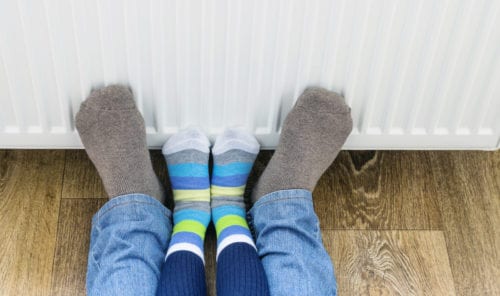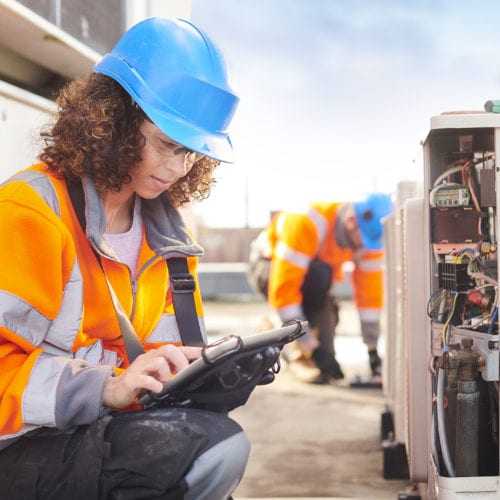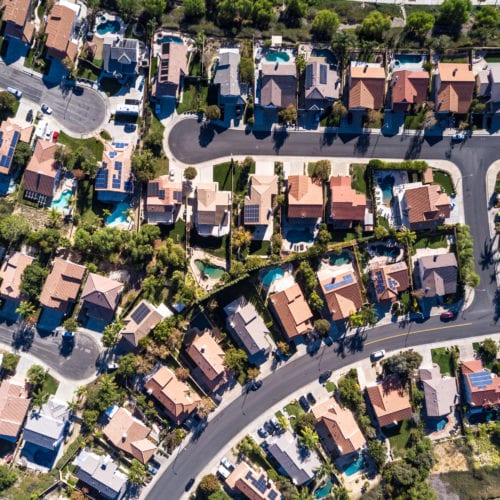A man and a child in winter socks warm their feet near the heater.

It’s Time to Incentivize Residential Heat Pumps
The United States has made significant progress decarbonizing the electricity sector in recent years, and as the grid continues to get cleaner, cities and states are turning their attention to other sectors, such as direct fossil fuel use in buildings. The use of gas or fuel oil for heating, hot water, and cooking accounts for more than 10 percent of US carbon emissions. All-electric building policies, which promote the use of electric appliances instead of fossil fuels, have gained traction from California to Massachusetts, and policymakers everywhere are paying attention.
States with ambitious climate change goals must address direct building emissions, but does electrification make sense everywhere at this moment? Can electric appliances reduce carbon emissions even in cold climates?
New Rocky Mountain Institute analysis answers those questions by examining each of the lower 48 states, focusing on the largest direct use of fossil fuel in buildings: home heating. We compared gas furnaces to a readily available electric alternative: air source heat pumps. Heat pump technology is a particularly efficient way to heat a home, delivering two to four times more heating energy than the electricity it consumes.
The results point to significant potential for states to slash direct building emissions by installing heat pumps. As of 2020, replacing a gas furnace with a heat pump will reduce carbon emissions in 46 of 48 states (99 percent of US households); all but Wyoming and Utah, which remain heavily reliant on coal-fired electricity. When compared to fuel oil, there is no question that heat pumps are a cleaner source of heat.
Our analysis found two key reasons why a heat pump purchased today will have lower carbon emissions than a gas furnace over the 15-year appliance lifetime: (1) modern heat pumps are significantly more efficient than gas furnaces, even in cold climates; (2) the electricity sector has reached a tipping point in reducing carbon emissions.
This new reality has several key implications for policymakers:
- Electrifying residential space heating is a critical lever to reducing carbon emissions across the country.
- The clock is ticking for policy movement. Between new construction and appliance replacements, 5 to 8 million US buildings will add or replace heating equipment each year. Each one of these decisions may lock in fossil fuel use in buildings for decades since gas furnaces have a 15- to 20-year lifetime.
- Lastly, there is no need to wait to install heat pumps. The lifetime climate benefits of electric equipment installed today will likely increase in years to come. Today’s market drivers (poor economics of coal, new state and local renewable energy targets) indicate an increasingly cleaner grid for years to come.
Looking at the Lifetime Emissions of an Appliance Purchased Today
A residential furnace is a long-term asset. If it breaks in 2020, it needs to be replaced this year. And once the purchase is made, households won’t be deciding again for more than 15 years—the lifetime of the appliance.
In most states today, converting from a gas furnace to a heat pump will reduce emissions on day one; but we must also consider the total emissions over the lifetime of the furnace. For a gas furnace, the emissions will always be roughly a pound of carbon dioxide gas for every 10 cubic feet of gas burned, every year, for as long as you use the furnace. But the story with electric heating is different. As the grid gets greener, electric heating will produce less carbon over time. Even if the grid isn’t clean enough until 2025, buying a heat pump today will still reduce emissions when considering the lifetime emissions from 2020 to 2035. This is the power of looking at the cumulative—or lifetime—emissions impact of furnaces. Our analysis considers cumulative emissions of the 15-year lifetime of a heat pump installed today using a future projection of grid energy sources conducted by the National Renewable Energy Laboratory (NREL).
Two factors influence the comparison between a heat pump and a gas furnace’s lifetime emissions: weather and electricity mix.
Heat Pumps Are More Efficient, Even in Cold Climates
Heat pump technology has improved significantly in recent years, flipping a commonly accepted narrative that it is not an efficient or dependable heating source. Even accounting for reduced efficiency in extreme cold weather, our analysis finds that modern air source heat pumps are more than twice as efficient as gas furnaces.
We calculated the operational year-round heat pump efficiency for the most populous city in each state by combining historical hourly weather conditions against the performance of modern, readily available heat pumps. Our analysis adjusted heat pump efficiency to account for backup electric resistance heat when and where it is needed—rarely, and during very cold days. For instance, in Fargo, North Dakota, which sees an average minimum daily temperature of -23°F (-30°C), this backup capability is needed for approximately 5 percent of the year.
The chart below shows the expected heat pump coefficient of performance (COP), which is a weighted average of the daily heat pump efficiency by heating degree days. A COP of 1 means the system is 100 percent efficient—heating energy is equivalent to electricity inputs. A COP of 2 means that for every kWh of electricity a heat pump consumes, it produces 2 kWh equivalent of heat.
Heat pumps ranged from 2.2 to 4.5 times more efficient than an Energy Star gas furnace on an annual basis, and in no climate was a heat pump less than 200 percent efficient (COP of 2). Efficiency was highest in places with mild winters, like California, Tennessee, and Arizona. However, heat pumps were also more energy efficient than gas furnaces in cold climates like Colorado, Minnesota, and Wisconsin. While this analysis did not model ground source, or geothermal, heat pumps, the overall conclusion is likely to be similar given their even higher COP than air source heat pumps.
Strong performance in cold climates is especially noteworthy, due to technology improvements in air source heat pumps over the last decade. Recent major advancements in heat pump performance include:
- Fine-tuned controls allow for seamless integration of electric resistance backup in the coldest of conditions.
- Industry partnerships have led to configuration with smart thermostats like Nest, resulting in better system response to users’ thermal comfort and preventing overheating.
- Variable speed compressor technology allows heat pumps to perform at optimal efficiency all year.
Additionally, given the recent expansion of the US heat pump market and the enormous potential for continued growth, we expect market competition and sales volumes to increase in the coming years, driving down heat pump system costs in the years to come.
A Greening Grid Means More Emissions Savings
The second key driver of lifetime emissions is the carbon intensity of electricity (in this case measured in average pounds of carbon dioxide emissions per megawatt-hour).
Carbon intensity has reduced significantly since 2005 in all states, with momentum increasing in the last two years. Coal generation—a disproportionately large contributor to carbon emissions from electricity—has declined 20 percent since 2018, mostly due to price competition from natural gas and renewables.
RMI’s analysis incorporated historical data from both the US Environmental Protection Agency and NREL’s Regional Energy Deployment System (ReEDS) model to project changes in carbon intensity for electricity consumed in each state. The ReEDS scenario was taken from the 2019 Standard Scenarios and assumed sustained low natural gas prices and low renewable energy costs through 2036 (consistent with recent trends and analyst expectations), resulting in 16 percent coal, 38 percent natural gas, and 44 percent zero-emissions generation from electricity by 2030 nationally.
From a policy perspective, the ReEDS model is moderate in its grid mix assumptions. The model assumes the achievement only of existing, binding state clean energy targets on their prescribed timelines. RMI did not incorporate other types of decarbonization commitments (executive orders, city resolutions, draft legislation), although if these were included, our results would show even more substantial emissions savings for all-electric equipment.
This could impact our conclusion for Utah in particular, given recent policy movement in the state, including HB 411, which would achieve net-100 percent renewable electricity by 2030 for Utah communities with ambitious clean energy goals. In a recent analysis, Sierra Club concluded that a complete phase-out of coal—something possible with additional clean energy commitments and market forces—extends the carbon emissions savings into all states.
Therefore, we consider our findings conservative. They do not require a significant uptick in decarbonization commitments, or non-market retirement of fossil fuel assets. One only needs to trust that existing, binding commitments will be achieved in the states that have them, and that market forces from low costs for natural gas and renewables will continue into the next decade.
The Path Ahead
For cities and states looking to act on climate change amid the COVID-19 crisis and subsequent economic recovery, the search is on for technologically feasible, high impact, and cost-effective solutions.
Building electrification presents such an opportunity. More than 30 cities have passed legislation mandating or incentivizing all-electric new construction since July 2019. Numerous cities and states are exploring a transition for existing buildings, often phasing in all-electric appliances as gas appliances reach their end of life.
RMI is engaged with city and state officials across the country to chart a path that meets our climate goals, is economically attractive and attainable, and is beneficial for frontline communities and labor along the way. And while the prevailing winds of power sector decarbonization should carry forward and be accelerated, for 99 percent of US homes, there is no need to wait for a cleaner grid to install a heat pump.
State policymakers and utilities should prioritize incentives that enable homeowners and landlords to electrify residential heating with heat pumps in the next legislative and planning sessions. While a handful of states like Maine and Vermont are already accelerating heat pump adoption, the advanced state of heat pump technology coupled with decarbonization of the electrical grid make heating with residential heat pumps a valuable tool for climate action for nearly every state today.
To see the data used for the analysis, click here.
This is one several upcoming pieces on the potential for Building Electrification across the country. Forthcoming pieces will focus on electrification in cold climates and the economics of electrifying buildings.

